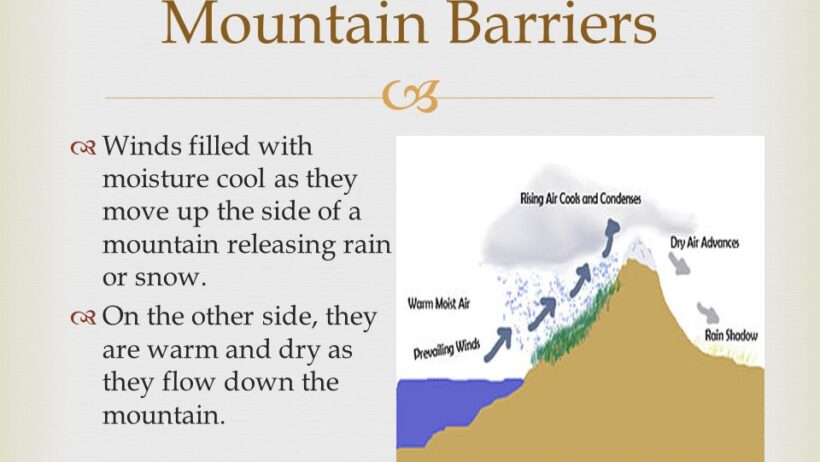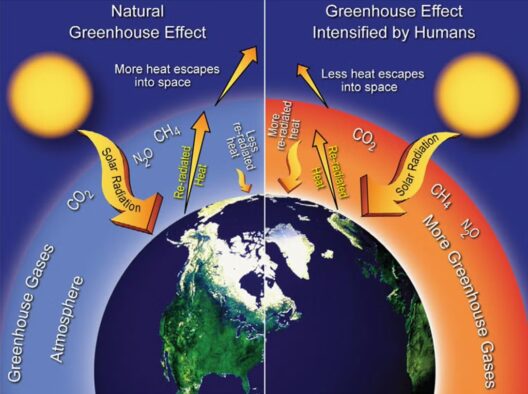In the vast tapestry of Earth’s climate systems, mountains emerge not merely as geographical features but as formidable players that orchestrate the atmospheric symphony of our planet. Have you ever wondered how towering peaks influence weather patterns across regions? The mechanics behind this phenomenon are intricate and fascinating, involving the interplay of topography, meteorology, and hydrology.
Mountains act as natural barriers, impacting not only the wind patterns but also the precipitation that regions experience. As moist air travels in from oceans or other large bodies of water, it encounters these formidable structures. The elevation of a mountain range forces the air to ascend, and in doing so, it cools. This is governed by the principle of adiabatic cooling, where rising air expands and cools, leading to condensation of water vapor and, ultimately, the formation of clouds. Thus, mountains play a pivotal role in the hydrological cycle, acting as catalysts for precipitation.
A striking example of this is the Cascade Range in the Pacific Northwest of the United States. The winds that flow in from the Pacific Ocean are laden with moisture. As these winds encounter the Cascades, they are compelled to rise, resulting in copious rainfall on the western slopes. This phenomenon plays a crucial role in supporting the region’s lush temperate rainforests. Conversely, as the air descends on the eastern slopes, it warms, leading to desiccation. This creates a stark contrast between the verdant landscapes of the west and the arid conditions of the east, illustrating the concept of rain shadows.
The term “rain shadow” specifically refers to the dry area on the leeward side of a mountain range, an indirect consequence of orographic lift. When moist air ascends the windward side of the mountain, it releases precipitation, resulting in rich ecosystems such as those found in the Olympic National Park. However, as the now-dry air descends the leeward slope, regions like Eastern Washington experience significantly lower precipitation levels, evolving into semi-arid landscapes. This demarcation is not merely a visual boundary but a fundamental determinant of biodiversity, agriculture, and local economies.
Mountains also interact with climate patterns on a broader scale. The presence of large mountain ranges can disrupt the flow of prevailing winds, creating distinct microclimates. For instance, the Himalayas, which form the mighty roof of the world, have profound implications on the monsoon climate of South Asia. As moist air flows in from the Indian Ocean, it collides with these imposing peaks, leading to intense rainfall over the Indian subcontinent. Without the towering Himalayas, the monsoon could potentially shift, altering agricultural patterns and water availability for millions.
Moreover, the influence of mountains extends beyond mere precipitation dynamics. They also act as barriers to air masses of different temperatures and humidities, leading to phenomena such as temperature inversions and altered local weather systems. The Alps and the Rockies provide compelling cases where such barriers create localized climatic conditions that can result in blizzards, dense fog, or even frost pockets, demonstrating the complexity of atmospheric interactions with topographical features.
Camp at the foot of a mountain during summer, and you may experience idyllic warmth during the day—yet at night, temperatures plummet due to the rapid cooling effects of elevation. This intense contrast is a reminder of how mountains can create thermal disparities that dictate not only daily weather patterns but also seasonal climate shifts. In such microclimates, specific plants and animals have adapted uniquely, showcasing an evolutionary marvel borne from the whims of mountain terrain.
The challenge posed by these ecological and climatological intricacies is profound. With climate change altering global weather patterns, the delicate balance that mountains help maintain is at risk. As temperatures rise and precipitation becomes increasingly erratic, the ecosystems that thrive in these diverse climates may face unprecedented stress. For instance, the glacial melt from mountains, a critical freshwater source for millions, is accelerating, creating future water scarcity issues in regions that rely upon these glacial rivers.
Furthermore, the increasing frequency of extreme weather events, such as torrential rain and droughts, is exacerbated by shifting atmospheric conditions caused by climate change. Forests that rely on consistent rainfall patterns are now at risk, while regions previously blessed with predictable wet seasons may find themselves submerged or parched. These realities compel society to rethink land use planning, water management, and conservation strategies, particularly in vulnerable mountain regions.
In conclusion, mountains stand not only as majestic natural features but as instrumental agents in shaping climate dynamics. Their role in directing winds, precipitating rain, and creating varied ecosystems is intricate and multifaceted. As humanity grapples with climate change, the lessons learned from these geological giants may prove invaluable. Understanding how mountains shape not only the climate around them but also the lives and livelihoods of those who inhabit their shadows is crucial. Protecting these unique ecosystems and the climatic benefits they offer should be a priority as we strive for a sustainable relationship with our environment.







